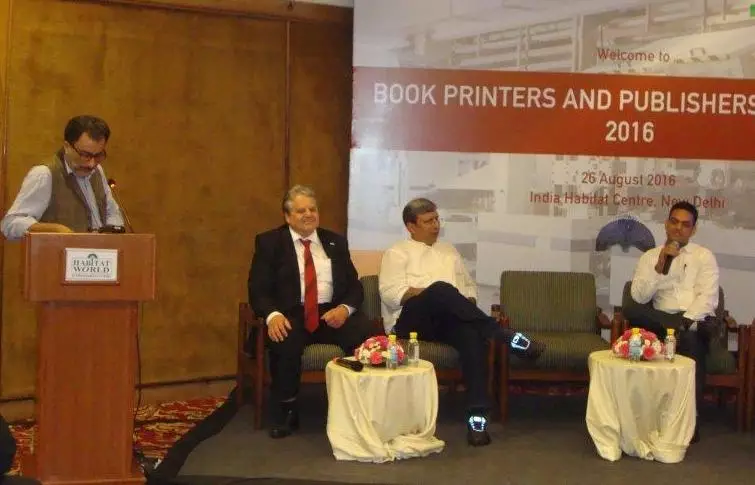Digital printing is the alternative to minimum order quantity - The Noel D'Cunha Sunday Column
Ajay Joshi of Penguin Random House India, a major trade publisher in India, works with three print partners, two conventional and one digital. In this Part II of the series on digital print in publishing, he says, digital printing has enormous potential in India. For this to succeed, publishers, printers, and technology providers have to come together under one platform; teamwork is the mantra.
In this Sunday Column, Joshi discusses moves that can make digital printing key to a nimble p
10 Sep 2016 | By Noel D'Cunha
Noel D’Cunha (ND): What has been your digital print experience thus far?
Ajay Joshi (AJ): Digital printing is the best alternative to minimum order quantity (MOQ) of conventional printing. It is the solution to the long-drawn challenge of high inventory in the industry.
ND: What is your assessment of the digital presses in India? As a publishing house, have you done a compare and contrast between different brands?
AJ: There are limited players, restricting the printer to choose from a handful. Technology is expensive and it is still away from providing desirable rates for printers to stay competitive. As a publisher, we want to deliver the best quality standards for our readers and authors and want to have no quality difference between offset and digital. For digital press manufacturers, this is a point worth noting.
ND: The Nielsen India Book Market Report 2015 estimated India’s print book market to be worth Rs 26,060 crore. Some say the numbers are more. How much of this, according to you, will migrate toward digital print and why?
AJ: Out of Rs 26,060 crore, the biggest share is that of education (K-12 and higher education), approximately 93%. There is huge opportunity for digital production. I believe it’s important for publishers, printers and manufactures of these machines to come together as a team. We ensure to work very closely with our print partners and hold brainstorming sessions every quarter to see the future of print production and the challenges ahead. Without a worthy work relationship, targets can get difficult to achieve. We consider our printers our partners and work in tandem with them, leaving no scope of lapse.
ND: The educational books sector, which forms 70% of the book market, is the bulwark for the publishing industry. In what way can digital print be an asset to this segment?
AJ: This 70% is just K-12 education market. If we consider the higher education market, this adds to another 22%. Digital printing, alongside reducing the inventory, will support quicker deliveries, scope for customisation and routine content update.
ND: Do we need to look at the costing structure and business model?
AJ: The costing structure does vary and it can be made cost-effective. Affordability can be brought by expansion and variety.
ND: The big challenge in publishing is the loss due to delays in printing. How can fast turnaround times and Print on Demand solve these issues?
AJ: Faster turnaround is the key for any industry and an important part of healthy demand and supply process. Faster turnaround time is one of the reasons behind the birth of digital printing. We have come a long way and there is still lot to be achieved.
ND: Then there are issues of piracy, client confidentiality and slow-moving inventories...
AJ: Quicker turnaround time for production will limit and control piracy. The business of piracy is based largely on demand cycle and we can break it by delivering as per the market need.

ND: Why print partners are not confident in investing in digital technology?
AJ: The biggest bottleneck is turnaround time. Every customer wants his product to be delivered the next day. Digital or offset production is not his consideration. No organisation prefers to lose customer due to non-availability or delayed deliveries. Digital is the one-stop solution to keep pace with the demand. As for the cost concerns, the investments are huge and is not affordable to every printer. Book as a product is a low margin business and every publisher want lowest production cost to maintain these margins.
ND: How can publishers work with printers to eliminate waste, enhance operational efficiencies and thereby lowering the costs in the value chain? Who will bear the cost in all this? Nobody is prepared to do it!
AJ: Brainstorming sessions with publishers, printers and technology providers under one platform may find a solution to this question. Teamwork will be a key.
ND: What would you be looking for in your partner in the area of digital print/POD?
AJ: We would want our print partner not just a print provider, but a complete service provider. We have printers who are offering services even in electronics.
ND: What would be your advice to a book publisher or a book-printing firm to cope with in this brutal day and age?
AJ: Before investing in a new technology, printer should make sure that they have utilised their existing technology to its best. See if there is a scope of enhancement instead of investing in a new project. Process reengineering is required to match the pace of changing technology and the customer demands.
ND: Though we agree that digital printing is the future trend, why are Indian printers not confident to invest in CF inkjet presses? How can major publishers like you help them to gain confidence?
AJ: As I said, we encourage discussions and brainstorming sessions with our service providers and we will remain open to any discussions. There is an imbalance in the ratio of offset and digital presses. The sooner this difference is matched, the better. Technology providers should project affordable machines to attract the eagerly waiting printers and try encouraging their expectations. It is a vicious circle and there is a need to work together.














 See All
See All